Corvette, Birth Of An Automotive Icon
by: Robert Morgan

Custom 1965 Corvette image By Brett Weinstein (Wikipedia User: Nrbelex) (2006 Scarsdale Coucours) [GFDL (http://www.gnu.org/copyleft/fdl.html), CC-BY-SA-3.0 (http://creativecommons.org/licenses/by-sa/3.0/) or CC BY 2.5 (http://creativecommons.org/licenses/by/2.5)], via Wikimedia Commons
It is said that William Durant, the founder of General Motors told that a wallpaper pattern he saw in a Paris hotel in 1908 inspired the bowtie logo. Legend has it, he ripped off a small piece of the wallpaper and brought it back to Detroit. The bowtie logo was used for the first time in 1914 and has remained Chevrolet’s ever since.
In 1926, while working on customizing coachwork at a Cadillac dealership in Hollywood, Harley Earl was discovered by Lawrence P. Fisher, the general manager of Cadillac. Earl’s first assignment was to design the 1927 LaSalle, the first of Cadillac’s companion, and his creation was a huge success. From this point on Harley Earl worked full time for General Motors with his specific task of setting up an in-house styling department. Even then, Harley Earl had an idea rambling around in his head for a two-seater sports car for the American public, build in America, with all the whistles and bells the American public was looking for. They just didn’t know it yet.
By 1950, the United States automotive industry was stretching its steel resources to the breaking point. Hot on the heals of World War II’s appetite for steel, steel was needed for automobiles, but it was was also needed for the war effort in building tanks, ships, and shells bound for Korea. Fiberglass appeared to be the front runner and most appealing alternative for the short supply of steel. Also during these post war years, GI’s had been returning home from WWII in Europe, and were bringing back with them European two-seater sport cars. At that time no American automobile manufacturer was making anything that would compete with the Italian Ferrari’s and Alfa Romeos. These exotic little two-seater’s also from England’s’ car makers produced the sensuous Jaguar XK120, the MG-TC, Aston Martins, and Triumphs. In the late 1940’s the already legionary General Motors designer, Harley Earl, saw clearly that the American automobile market needed its own exotic little two-seater to compete with what the young post-war American solders were demanding.

Corvette Dashboard courtesy of Pixabay
Early in 1952 Harley Earl had completed his full-size clay model, and presented it to then General Motors President Harlow Curtice Earl’s aim was to produce a sports car and unveil it at the 1953 traveling show called Motorama. That year Harley Earl, in his Motorama, introduced the Le Mans, the Cadillac El Dorado, the Oldsmobile Wildcat, and the Pontiac Parisienne. The Starfire, Wildfire, and Le Mans concept cars were made of fiberglass instead of the long time used stamped metal sheeting. The 1953 Motorama also featured a sporty two-seat roadster from Chevrolet. Once shown to Chevrolet General manager Tom Keating and chief engineer Ed Cole the Chevrolet Corvette was on its way to setting the bar for ”America’s Sport Car”. The little two-seater was off and running, but had no name. Myron Scott was credited with coming up with the name from his experience with the fast naval vessels that performed patrol duties during WWII as destroyer escorts. Scott suggested using the name of these little fast boats, Corvette, for the new little car. Harley Earl liked it immediately, and so the car debuted at the 1953 Motorama with its Polo White fiberglass finish glistening under the center stage spotlights. The Chevrolet Corvette was born in fiberglass. Harley Earl and the management entities of Chevrolet as well as General Motors all agreed that this was the building material for future generations in the automobile industry.
The initial Corvette came equipped with an underpowered in-line 6 cylinder since Chevrolet Division of GM had no V-8. Harley Earl also had to hook up his modified 6 cylinder with the tried and proven two-speed power glide automatic since Chevrolet Division also had no 4-speed transmissions available. The engineering staff was able to squeeze out 150 horse power from the “Blue Flame Six” by adding mechanical lifters, an aluminum intake manifold with three single barrel Carter carburetors, duel exhaust, and increasing the compression ratio from 7.5:1 to 8.0:1. They renamed the engine the “Blue Flame Special”; however, it still came up short against the Jaguar’s 180 horsepower. The new sport car just did not live up to what the American public was looking for in a sporty two-seater with it’s golden plastic side curtains. The European counter parts had captured all the zippy, flashy, penuche in this segment of the automobiles’ buying public, and Harley Earl made it his quest to change the buying publics concept of an American sporty two-seater.
The initial production fiberglass facility for the Corvette was in St. Louis and had the capacity to produce 10,000 units a year. The final assembly facility in Flint Michigan, was small with a line long enough for only six chassis. The initial start up was slow and it took three crews three 16 hour days to assemble the first car. Through July they were satisfied to finish one unit per day. Then during August the units jumped to 3 per day. The facility produced just 3,640 units for 1954, with a third remaining unsold at the end of the year. While General Motors introduced the Corvette at $3,733 fully equipped in 1953, it listed the base price at $3,498. However, for 1954 the base price was reduced to $2,774.. Harley Earl’s little dream car hit the market with much less enthusiasm than he had expected. Its performance and handling was also well below the bar for the post war V-8 Convertible market Chevrolet had been aiming at.
The engineering department for Chevrolet made only a few improvement to the 1954’s performance by using a higher performing camshaft. However, this only produced an addition 5 horsepower topping the Blue Flame Six to 155 horsepower. Money was tight and Chevrolet was only able to add two additional colors to the White with Red interior. That being Black and Sportsman Red, all with Red interior. Late in 1954, Corvette’s began to appear in Pennant Blue, and Chevrolet changed the Black top of 1953 to Tan for 1954. The Corvette was only a step away from extinction because of its own production difficulties, but Ford had announced in March 1954 that it was going to release a “Y” block 160 horsepower Thunderbird for 1955 with roll-up windows and would sell for $2,695. It seemed that Ford had hit the market Chevrolet was aiming for by being able to produced and sell 16,155 units, as where the Chevrolet Corvette had stopped production after only 700 cars due to the lack in demand. The 1955 Thunderbird had taken away from General Motors, the audience two years earlier Harley Earl attempted to capture.

Chevrolet Corvette Logo image courtesy of Pixabay
As Chevrolet’s Management struggle with the future for the Corvette, Chevrolet’s Studio Division headed by Clare Mackichan, and the Engineering Division headed by Ed Cole pressed on with as many updates and revisions money would allow. On October 15, 1954 Zora Arkus-Duntov wrote a memo to Ed Cole and Maurice Olley noting that the Corvette appeared to be a failure. He suggested to drop the Corvette; however, that would be an admission of failure and a public embarrassment to all of Chevrolet. He further suggested some modifications to the car and improvements to the sales effort. He wanted to create a separate department within Chevrolet to oversee Corvette’s development.
For the entire 1954 production period for Corvette, the little car was still considered by reviewers and enthusiasts alike to lack the performance needed for the audience Chevrolet was aiming for. Chevrolet’s Engineering staff began working on the horsepower and handling performance problems that plagued not just Corvette, but also it’s mother division, Chevrolet. The engineering staff designed and developed a new 231-cubic inch displacement overhead-valve engine V-8. Ed Cole wanted to increase the V-8 to 265-cubic inch displacement, and Tom Keating was in full agreement. With Keating’s sanction, GM chairman Alfred Sloan approved the project without ever seeing the engineering designs. Now Cole needed his staff to design and build a running model. They accomplished the task in only 15 weeks. Cole was so concerned with Corvette’s future that he ordered tooling and plant space before Barr and his engineers even fired up the new small block 265 for the first time.
The engineering staff at Corvette were anxious to see how the new engine would improve the little car’s performance that they refitted the 1953 Motorama show car, EX-122, with the prototype V-8. The little car ran without incident at Milford for 25,000 miles. The new motor was coupled with a three-speed manual transmission, in addition to the now tried and perfected Powerglide automatic. With the 1955 model came the Corvette with Chevrolet’s first V-8 engine; however, overall performance was held back due to the vast majority being mated with the automatic transmission. Even so, the new engine put the vastly needed life into the Corvette. Performance jumped as 0-60 miles per hour times cut a full three seconds to eight seconds for the late 1955 cars fitted with the three-speed manual transmission. Top speed also climbed to 120 miles per hour, and fuel consumption improved from 17 miles per gallon to a full 20 miles per gallon.
At the end of 1955 production the numbers of units sold would have put ordinary men to the showers, defeated and humiliated. But Earl, Cole, Keating, and Curtice were not your everyday run of the mill visionaries. Chairman Alfred Sloan had already announced “The question is not simply one of maximizing the rate of return for a specific short period of time…[but] the fundamental consideration was an average return over a long period of time”. Since sales for other automobiles produced, Chairman Alfred Sloan informed the board of General Motors that it could afford to be patient. General Motors marketing department research indicated that 17 percent of American households were now two-car families. Chevrolet once again outsold Ford overall in 1955, 1,646,681 to 1,573,276 units. However, Ford had found 16,155 Thunderbird buyers where Chevrolet Corvette had not.

C3 Corvette image courtesy of Pixabay
Chevrolet Division knew it had found the golden egg with it’s new 265 cubic inch V-8, and that the Corvette had just not caught the buyers’ eye. While watching Ford’s success with the Thunderbird, Sloan believed that Corvette was the right car for General Motors and Chevrolet at the time, even if they didn’t have the little car “right” yet.
THE CORVETTE STARTS WITH PRODUCTION NIGHTMARES
By the time of the 1956 Motorama it was evident that Harley Earl’s stylists crew and Cole’s engineers working together had transformed the little two seater to a much more desired two-seater. Driven by the memo Zora Arkus-Duntov had written served as a wake-up call to the Chevrolet Division at General Motors. Arkus-Duntov saw car-enthusiast magazines fill with stories about Ford’s new Thunderbird. He believed Chevrolet could penetrate this market, and he proposed that General Motors Chevrolet Division produce engine and chassis performance parts to market to the general public. Before Tom Keating had approved production of the Corvette for two more years, the Corvette’s Division at Chevrolet designers and engineers were sorting out significant changes to entice buyers for 1956. The introduction of Corvette’s Regular Production Option (RPO) dual four-barrel carburetors, RPO 469, provided big news for 1956. Buyers felt the improvement from 195 to 225 horsepower. These six SR models, using RPO 449 with slightly higher camshafts (the so-called Duntov cams) boosted Corvette’s power plant to 240 horsepower. Also SR models featured a shorter steering column to allow drivers more room to move their arms while cornering.
For the 1956 Corvette, the wanted design changes were supposed to look like the 1958 and 1959 models with four headlights and three front air intakes. Styling and engineering were overwhelmed with the big changes to the Chevrolet passenger car and pickup truck line, and they got swamped. Compounded by poor revenues from the dismal 1954 sales, little time and no money meant only minor changes were possible for the 1957 Corvette.
In 1957 the little porthole Thunderbird was in it’s last year of production, and the little car from Chevrolet’s dream pool had a leg up in performance and handling. The American Icon Sports Car had found it’s way from almost extinction.
| About The Author
My dream since high school has been to own a Corvette. It took me to age 52 for my dream to come true with the ownership of a 1985. I am fascinated with them since I saw my first ’57 up close and personal. I research my dream car from every source I can, just to know more. I expect that I will be writing more about Corvettes in the future as I find more details about them.
The author invites you to visit:
http://www.theautoprofessor.com |
Article Source:
http://www.articlecity.com/articles/auto_and_trucks/article_3051.shtml
